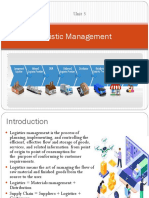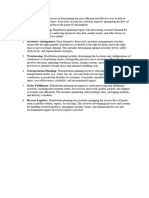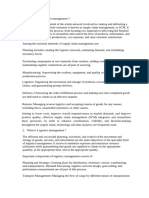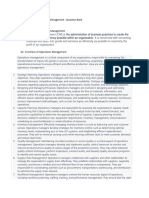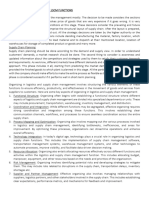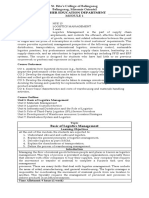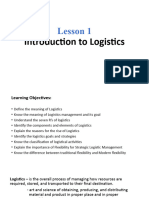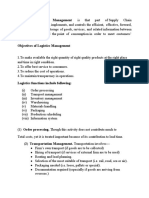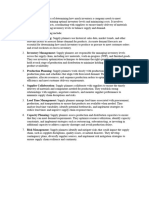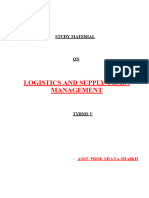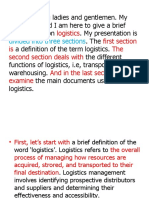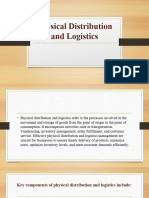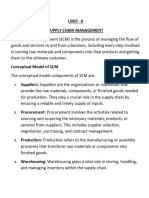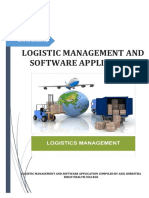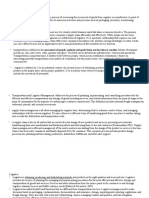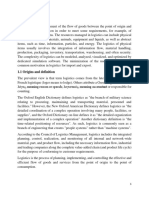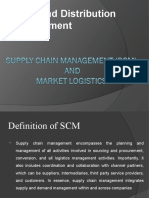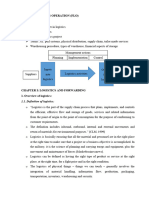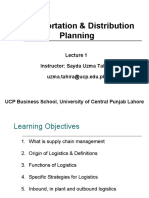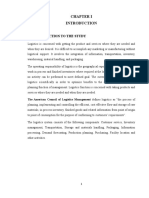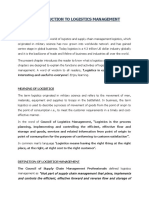SCM Logistics Planning
SCM Logistics Planning
Uploaded by
syedtalhamanzarCopyright:
Available Formats
SCM Logistics Planning
SCM Logistics Planning
Uploaded by
syedtalhamanzarCopyright
Available Formats
Share this document
Did you find this document useful?
Is this content inappropriate?
Copyright:
Available Formats
SCM Logistics Planning
SCM Logistics Planning
Uploaded by
syedtalhamanzarCopyright:
Available Formats
Logistics planning refers to the process of strategically coordinating the movement and storage of
goods, information, and resources throughout the supply chain to ensure efficient and timely delivery
of products to customers. It involves detailed planning, organization, and management of various
logistics activities, including transportation, warehousing, inventory management, and distribution.
Key aspects of logistics planning include:
1. Transportation Planning: This involves selecting the most appropriate transportation modes
(e.g., road, rail, air, sea) and routes to move goods from suppliers to manufacturers, between
production facilities, and from distribution centers to customers. Logistics planners consider
factors such as cost, transit time, reliability, capacity, and environmental impact when making
transportation decisions.
2. Warehousing and Distribution Center Planning: Logistics planners determine the optimal
location, layout, and operation of warehouses and distribution centers to support efficient
order fulfillment and inventory management. They design storage systems, implement
material handling equipment, and establish inventory control processes to facilitate the
smooth flow of goods in and out of facilities.
3. Inventory Management: Logistics planning involves managing inventory levels strategically
to balance supply and demand while minimizing holding costs and stockouts. Planners use
techniques such as demand forecasting, safety stock optimization, and ABC analysis to
determine optimal inventory levels, storage locations, and replenishment strategies.
4. Order Fulfillment Planning: Logistics planners develop order fulfillment processes and
workflows to ensure accurate and timely processing of customer orders. This includes order
picking, packing, and shipping activities, as well as order tracking and status updates to
customers.
5. Reverse Logistics Planning: Logistics planners also address the management of reverse
logistics, which involves handling product returns, repairs, recycling, and disposal. They
develop efficient processes for handling reverse flows of goods and materials, minimizing the
impact on overall supply chain costs and environmental sustainability.
6. Information Systems and Technology: Effective logistics planning relies on advanced
information systems and technology platforms to track shipments, monitor inventory levels,
optimize transportation routes, and facilitate communication and collaboration across the
supply chain. Logistics planners leverage tools such as transportation management systems
(TMS), warehouse management systems (WMS), and enterprise resource planning (ERP)
software to streamline logistics operations and improve visibility and control.
7. Risk Management: Logistics planners also assess and mitigate risks associated with
transportation delays, disruptions, security threats, and natural disasters. They develop
contingency plans, establish alternative supply chain routes, and collaborate with suppliers
and logistics partners to minimize the impact of potential disruptions on supply chain
performance.
You might also like
- Logistic Management: Unit 3Document23 pagesLogistic Management: Unit 3Akhil Crasta100% (1)
- Logistics Management-Unit2 CompleteDocument93 pagesLogistics Management-Unit2 CompleteVasanthi Donthi100% (1)
- The Book of EnochDocument137 pagesThe Book of EnochSyncOrSwim100% (19)
- أثر تبني ركائز الإدارة الرشيقة فى المشاريع أجايل Agile على نجاح تسويقDocument22 pagesأثر تبني ركائز الإدارة الرشيقة فى المشاريع أجايل Agile على نجاح تسويقمكتب التعليم شرق الطائفNo ratings yet
- SCM Distribution PlanningDocument1 pageSCM Distribution PlanningsyedtalhamanzarNo ratings yet
- Introduction To Logistics ManagementDocument29 pagesIntroduction To Logistics Managementacostaaugusto24No ratings yet
- Logistics Unit 1Document14 pagesLogistics Unit 1vikivignesh2331No ratings yet
- Mitesh GuptaDocument3 pagesMitesh GuptaB-48 Dev SinghNo ratings yet
- Unit 4 Logistics ManagementDocument6 pagesUnit 4 Logistics Managementadityasaraswat704No ratings yet
- Operations and Supply Chain ManagementDocument27 pagesOperations and Supply Chain ManagementMahesh KhedkarNo ratings yet
- Sourcing - Logistics - LEC01 04102023 064133pmDocument31 pagesSourcing - Logistics - LEC01 04102023 064133pm7drkn2vtybNo ratings yet
- Planning & OrganizingDocument3 pagesPlanning & Organizingchops95luvNo ratings yet
- Fundamental Principles of Logistics and Supply Chain ManagementDocument7 pagesFundamental Principles of Logistics and Supply Chain ManagementjohnpaulviNo ratings yet
- Intoduction To Supply Chain ManagementDocument32 pagesIntoduction To Supply Chain ManagementKriselle Pearl TonhayNo ratings yet
- Product and Operations ManagementDocument26 pagesProduct and Operations ManagementDEBOLIN SARKAR 2120744No ratings yet
- Ritesh Kurlap Logistics ManagementDocument17 pagesRitesh Kurlap Logistics ManagementVikas DubeNo ratings yet
- HRE 13 Module 1Document22 pagesHRE 13 Module 1Katrina JaponaNo ratings yet
- Distribution Management Module MidtermDocument26 pagesDistribution Management Module Midtermcarllibante12No ratings yet
- Concept of LogisticsDocument38 pagesConcept of LogisticsSoham100% (1)
- 1-Basics of LogisticsDocument15 pages1-Basics of Logistics20-UCO-517 AJAY KELVIN ANo ratings yet
- Unit 3 - POMDocument26 pagesUnit 3 - POMRushil KhajanchiNo ratings yet
- Lesson 1Document54 pagesLesson 1Daniel EsquivelNo ratings yet
- Unit 1logistics ManagementDocument13 pagesUnit 1logistics ManagementSidhu boiiNo ratings yet
- Logistics ManagementDocument52 pagesLogistics ManagementDeva Ardha Nareswara67% (9)
- Assignment 3 - FINAL PERIOD - Auditing Distribution - October 15, 2024Document2 pagesAssignment 3 - FINAL PERIOD - Auditing Distribution - October 15, 2024Princess TapangNo ratings yet
- TOPICDocument3 pagesTOPICMike PimentelNo ratings yet
- AthulDocument62 pagesAthulGokul KrishnanNo ratings yet
- Objectives of Logistics ManagementDocument3 pagesObjectives of Logistics Managementmdasif04No ratings yet
- Semis IVDocument2 pagesSemis IVnglc srzNo ratings yet
- SCM Supply PlanningDocument1 pageSCM Supply PlanningsyedtalhamanzarNo ratings yet
- LSCM CHP 1 NotesDocument77 pagesLSCM CHP 1 Notesaniket.anavkar030No ratings yet
- QN and Ans SCMDocument15 pagesQN and Ans SCMjnangole5No ratings yet
- Planning and Inventory ManagementDocument3 pagesPlanning and Inventory ManagementKarthikNo ratings yet
- Logistics First Section Is The Second Section Deals With and in The Last Section, I Will ExamineDocument11 pagesLogistics First Section Is The Second Section Deals With and in The Last Section, I Will ExaminesouhailNo ratings yet
- International Marketing MixDocument16 pagesInternational Marketing MixPriyanshu KalkhudiyaNo ratings yet
- Assigment - SCMDocument16 pagesAssigment - SCMkanishqjoshi5No ratings yet
- Unit 4Document11 pagesUnit 4Vinit RajNo ratings yet
- Logistic Management and Software ApplicationDocument155 pagesLogistic Management and Software ApplicationAsmitNo ratings yet
- Transportation ManagementDocument3 pagesTransportation Managementfrancis zapata marinNo ratings yet
- Transportation ManagementDocument3 pagesTransportation Managementfrancis zapata marinNo ratings yet
- Examine Systems Thinking in Logistics ManagementDocument2 pagesExamine Systems Thinking in Logistics ManagementFredrick munkombweNo ratings yet
- Assignemnt Logistic ManagmentDocument9 pagesAssignemnt Logistic ManagmentAsif Saleem GeologistNo ratings yet
- Evidencia 7 Evaluacion 19-2Document8 pagesEvidencia 7 Evaluacion 19-2cindy carolina soto pabonNo ratings yet
- Distribution and Logistics Session 1 PDFDocument6 pagesDistribution and Logistics Session 1 PDFCeddie UnggayNo ratings yet
- Market Logistics and SCMDocument6 pagesMarket Logistics and SCMBalramNo ratings yet
- Supply Chain and Logistics in Marketing - CDocument20 pagesSupply Chain and Logistics in Marketing - CvibuNo ratings yet
- Operations ManagementDocument6 pagesOperations ManagementheyzzzNo ratings yet
- FLO201FDocument49 pagesFLO201FTuấn BáchNo ratings yet
- Transportation & Distribution Planning: Instructor: Sayda Uzma Tahira Uzma - Tahira@ucp - Edu.pkDocument27 pagesTransportation & Distribution Planning: Instructor: Sayda Uzma Tahira Uzma - Tahira@ucp - Edu.pkArsalan ZahidNo ratings yet
- Lecture 1 Logistics MGTDocument3 pagesLecture 1 Logistics MGTLiezel RamosNo ratings yet
- 2 Logistics in SCM 1Document29 pages2 Logistics in SCM 1Khai Wen OnexoxNo ratings yet
- Logistics OperationDocument21 pagesLogistics OperationCJ David100% (1)
- Big BazaarDocument57 pagesBig BazaarShivamitra ChiruthaniNo ratings yet
- Notes on Material, Goods , Cargo Flow, Whse Ops, Handling EquipmentsDocument13 pagesNotes on Material, Goods , Cargo Flow, Whse Ops, Handling Equipmentsmon.aphroditeeeNo ratings yet
- 3PL Lecturer # 01 18-02-2024 Final, Prepared and Delivered by M. Akber Manzoor Khan - KIET, Spring 2024Document29 pages3PL Lecturer # 01 18-02-2024 Final, Prepared and Delivered by M. Akber Manzoor Khan - KIET, Spring 2024akbermanzoorkhanNo ratings yet
- 1600182991unit 1 Introduction To Transport ManagementDocument11 pages1600182991unit 1 Introduction To Transport ManagementdommacleodNo ratings yet
- Chapter 55 Project Logistics Management1Document23 pagesChapter 55 Project Logistics Management1Mitku AssefaNo ratings yet
- Logistics Management An IntroductionDocument24 pagesLogistics Management An Introductionorly briggsNo ratings yet
- Chapter - 1 Introduction To Logistics ManagementDocument38 pagesChapter - 1 Introduction To Logistics ManagementShruti100% (2)
- LCM Cometitive AdvantagesDocument6 pagesLCM Cometitive AdvantagessaisattvaconsultancyNo ratings yet
- Fundamentals of Logistics and Warehousing: The Supply Chain Journey, #4From EverandFundamentals of Logistics and Warehousing: The Supply Chain Journey, #4No ratings yet
- Procedure and Documentation in Supply Chain Management: Business strategy books, #1From EverandProcedure and Documentation in Supply Chain Management: Business strategy books, #1No ratings yet
- Tarea Silver MealDocument4 pagesTarea Silver MealsyedtalhamanzarNo ratings yet
- Silver Meal Least CostDocument6 pagesSilver Meal Least CostsyedtalhamanzarNo ratings yet
- Production Planning and Optimization SheetsDocument6 pagesProduction Planning and Optimization SheetssyedtalhamanzarNo ratings yet
- SCM Inventory PlanningDocument1 pageSCM Inventory PlanningsyedtalhamanzarNo ratings yet
- SCM Demand ForecastingDocument1 pageSCM Demand ForecastingsyedtalhamanzarNo ratings yet
- French Revolution 1789Document34 pagesFrench Revolution 1789guess it's meNo ratings yet
- CPC - Representative SuitDocument16 pagesCPC - Representative Suitgaurav singh100% (6)
- A. Fernandez v. MERALCODocument10 pagesA. Fernandez v. MERALCOCharmNo ratings yet
- Unamuno y El Monólogo Interior PDFDocument25 pagesUnamuno y El Monólogo Interior PDFPaquinho1985100% (1)
- Job Application Sample +resumeDocument3 pagesJob Application Sample +resumesg220287No ratings yet
- Screenshot 2023-09-12 at 19.25.48Document2 pagesScreenshot 2023-09-12 at 19.25.48aabcdefg1234321No ratings yet
- F08643s-Z0205-03-Detail Drawing of Rainwater Trench - CsDocument9 pagesF08643s-Z0205-03-Detail Drawing of Rainwater Trench - CswaheedNo ratings yet
- Bir Revenue RegulationDocument140 pagesBir Revenue RegulationMartin EspinosaNo ratings yet
- Or Al Au Aw Reading PackDocument3 pagesOr Al Au Aw Reading PackngubushenNo ratings yet
- Fray Botod By: Lopez Jaena GracianoDocument6 pagesFray Botod By: Lopez Jaena GracianoKyla Francine TiglaoNo ratings yet
- Answer Sheet FLT JHSDocument3 pagesAnswer Sheet FLT JHSLuke AntigaNo ratings yet
- Giorgio Moroder BioDocument1 pageGiorgio Moroder BioCaroline HamiltonNo ratings yet
- Range Division: KHS Engineering TechnologiesDocument2 pagesRange Division: KHS Engineering TechnologiesVenu GopalNo ratings yet
- Reply of Comrade Sanjaya Jayasekera To Socialist Equality Party GS Against His Expulsion in November 2022Document7 pagesReply of Comrade Sanjaya Jayasekera To Socialist Equality Party GS Against His Expulsion in November 2022Sanjaya Wilson JayasekeraNo ratings yet
- Midwest Drug TraffickingDocument24 pagesMidwest Drug TraffickingJosh YounisNo ratings yet
- Module 2 - Forwards & FuturesDocument84 pagesModule 2 - Forwards & FuturesSanjay PatilNo ratings yet
- John C Slessor and The Genesis of Air InterdictionDocument7 pagesJohn C Slessor and The Genesis of Air Interdictiontemplecloud1No ratings yet
- 153 Pma Mcq.Document28 pages153 Pma Mcq.sikandar khanNo ratings yet
- R12.2 Oracle Inventory Management FundamentalsDocument84 pagesR12.2 Oracle Inventory Management FundamentalsSyed Arshad PashaNo ratings yet
- New F ODI 2056 Syllabi Template Form Revision No 7 January 10 2024 4Document17 pagesNew F ODI 2056 Syllabi Template Form Revision No 7 January 10 2024 4melanie concejaNo ratings yet
- 5.NOTES Charles CorreaDocument18 pages5.NOTES Charles Correa1BQ19AT070 Prathik Yash PraveenNo ratings yet
- New Thought Movement and VedantaDocument2 pagesNew Thought Movement and VedantaDr Srinivasan Nenmeli -K100% (2)
- Aiden WachDocument2 pagesAiden WachawachNo ratings yet
- Ender's Game Violence AnalysisDocument4 pagesEnder's Game Violence Analysisspencersosnowski100% (1)
- 16 PMK 03 2010 (English) PDFDocument7 pages16 PMK 03 2010 (English) PDFoktovianshNo ratings yet
- Manual Ball Valves PLDocument23 pagesManual Ball Valves PLrirodrig139No ratings yet
- Student Handbook 2021-22Document14 pagesStudent Handbook 2021-22Saharsh jainNo ratings yet
- Biografi Penemu TencentDocument1 pageBiografi Penemu TencentAgustina PanjaitanNo ratings yet
